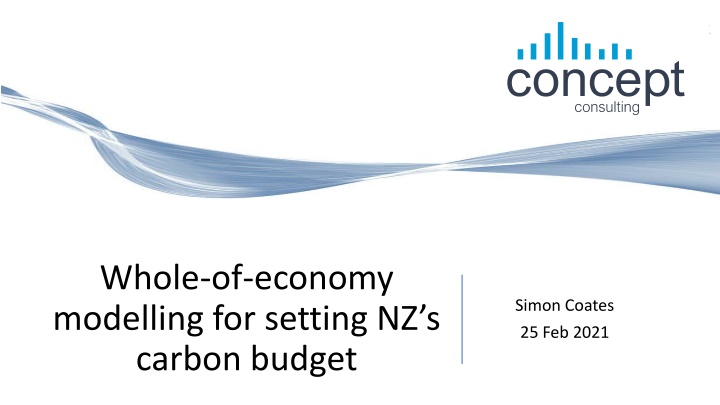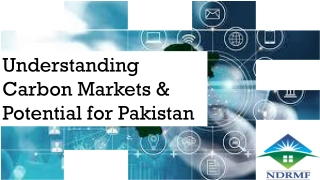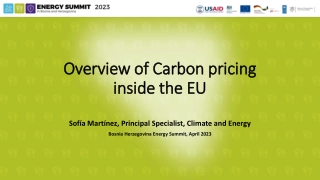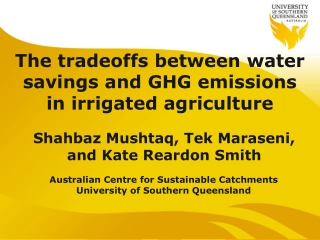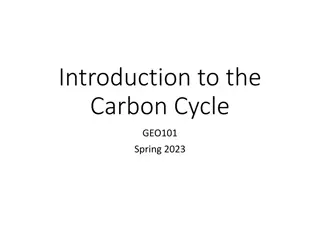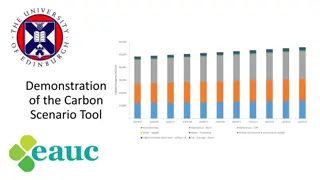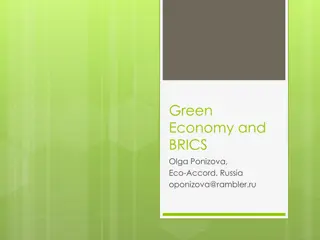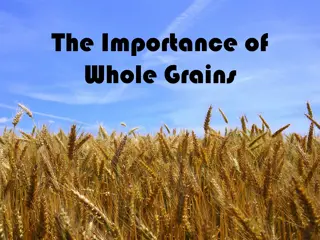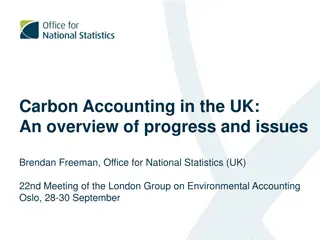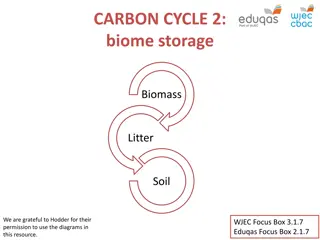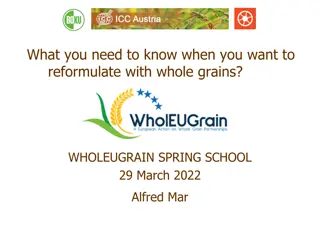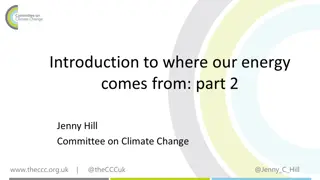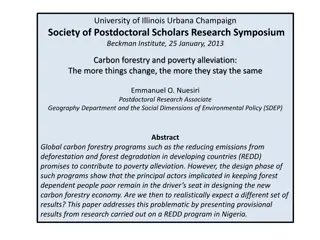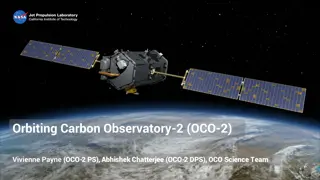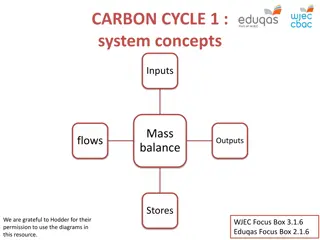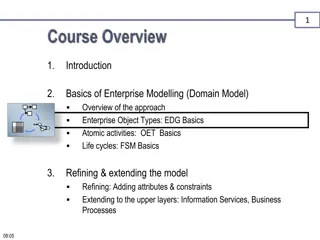Whole-of-Economy Modelling for Setting NZ's Carbon Budget
The core models aim to address key challenges in modeling New Zealand's emissions from various sectors and activities. By utilizing a powerful multi-sectoral model, decisions by economic actors are simulated based on factors such as technology costs, carbon prices, and policy settings to predict altered emissions and economic outcomes. The system captures sector-specific dynamics and inter-linked activities within the economy, facilitating detailed modeling of price and quantity flows across different sectors.
Uploaded on Mar 11, 2025 | 0 Views
Download Presentation

Please find below an Image/Link to download the presentation.
The content on the website is provided AS IS for your information and personal use only. It may not be sold, licensed, or shared on other websites without obtaining consent from the author.If you encounter any issues during the download, it is possible that the publisher has removed the file from their server.
You are allowed to download the files provided on this website for personal or commercial use, subject to the condition that they are used lawfully. All files are the property of their respective owners.
The content on the website is provided AS IS for your information and personal use only. It may not be sold, licensed, or shared on other websites without obtaining consent from the author.
E N D
Presentation Transcript
Whole-of-economy modelling for setting NZ s carbon budget Simon Coates 25 Feb 2021
The CCCs core models ENZ CPLAN DIM Bottom-up, structural model CGE model Distributional impacts model GEN_2021_v01 2
Key modelling challenge NZ s emissions come from many different sectors and activities GEN_2021_v01 3
Key modelling challenge NZ s emissions come from many different sectors and activities Drivers in each sector are very different modelling sector-specific dynamics is critical These sectors and activities form an inter-linked system capturing the linkages with internal consistency is critical But ENZ built using MS Excel Allows for detailed sector-specific modelling Design enables modelling of linkages that matter (price & quantity flows) Powerful modelling tool fast GEN_2021_v01 4
Whole-of-economy multi-sectoral model ENZ Simulates decisions by economic actors (households, industry, land-owners). E.g.: Fuel-switching (e.g. ICE vs EV vehicle purchase) Investment in abatement tech. Land-use change Industry entry / exit Decisions based on lifetime cost-benefit of options (including capital costs) given price- signals faced by decision-maker Simulates altered emissions and economic outcomes based on changes in factors, such as: Technology costs Commodity prices Carbon prices Population growth Policy settings Decisions based on price signals faced by individual economic actors, factored by policy settings. GEN_2021_v01 5
Individual sector modules, but with price and quantity flows between sectors Scenario management (Technology costs, int l prices (carbon, commodities, oil etc.), population growth, etc.) Land Transport Industry Consumer energy Space Sheep/ beef Dairy Other Marine Food Refine Aviation MCV Cement Wood Forest Water Hort. Rail Alu. HCV Petro. Light LCV Bus Refrig. Steel LPV Other Rest-of- world Gas Field devt. Network Flex. Electricity - Wholesale - Network - - - Inputs, Outputs, Prices Price flow Waste Rest-of-NZ Quant flow Reporting mgmt. (Emissions, Prices, Costs, Employment, etc.) GEN_2021_v01 6
Seeks to only model the things which matter Physical dynamics and constraints. E.g. Variability of electricity demand and intermittency of some renewables Physical limits on land availability, biomass resource, or gas reserves (quantity & deliverability) Physical capacity constraints on some sectors output (e.g. aluminium, steel, methanol) Economic costs and constraints. E.g. Capital component of costs, and rate of capital turnover Fixed network cost recovery from changing network volumes changing consumer prices Policy settings. E.g. Electricity & gas consumer pricing approaches Possible policy instruments, e.g. an ICE ban, or ban on new gas connections Granularity of situations Geography: e.g. regional splits for land-sector & food processing Within-sector segments: e.g. different types of road transport, land quality, electricity use, energy consumer situations, etc. GEN_2021_v01 7
Modelling acknowledges that some decision-makers appear more economically rational than others Decision-maker ENZ modelling approach Based on the participant s price signals for the given scenario (e.g. technology, fuel, and carbon costs), and physical constraints For some decision-makers, price is key E.g. Power station investment, dairy plant process heat decision For other decision-makers, non-price factors can be just as important. E.g. Mass-market consumers vehicle purchase or building-heating decisions Non-price quality factors, and consumer behavioural biases (e.g. short-termism , status- quo bias) v. important Land-owner decisions strongly driven by non-price values Compounded by major uncertainties over abatement options (e.g. methane vaccine) Technology uptake curves, driven by price, but factored by price sensitivity assumptions Exogenously-based land-use and technology projections based off Ministry for Primary Industries projections and informed by modelled EBIT/ha evaluations GEN_2021_v01 8
Inherent uncertainties testing a range of futures is critical Scenario-management tool allows creation of internally-consistent composite scenarios built from multiple individual scenarios for key drivers (e.g. commodity prices, technology costs, population growth, etc.) CCC explored four composite scenarios spanning two dimensions of uncertainty Additionally, modelling process examined many more scenarios to test sensitivity of outcomes to key parameters, helping identify the assumptions that really matter GEN_2021_v01 9
Results GEN_2021_v01 10
Without further policy action, we are already projected to have significant reductions in net long-lived gas Biggest factors driving this : 1. Forestry expansion driven by <$50/tCO2 carbon prices 2. Significant transport shift to EVs due to global tech. change 3. Wind & geothermal driving out baseload fossil generation 4. Exit of some major industrials a. Methanol production, due to depletion of NZ s major gas fields (with no further exploration) b. Aluminium smelting Target GEN_2021_v01 11
For biogenic methane, our without further action future looks more BAU Main factors driving projected modest decline Freshwater policy changes limiting further dairy expansion Some continued sheep & beef forestry conversion Target GEN_2021_v01 12
Modelling identified range of futures which would meet our targets Long-lived gases Biogenic methane GEN_2021_v01 13
Chosen path to 2035 projects reductions in key areas 36.3 -9.5 13.1 -14.5 Forestry Forestry 2035 Net 2018 Net GEN_2021_v01 14
Biggest transport issue is how fast we can go electric % of light vehicles which are electric entering the country of the total fleet Global tech dev t EVs are anyway projected to have significant uptake Chosen NZ path accelerates uptake to more cost-effective levels Increased mode-shift to active and public transport another modelled outcome in chosen path GEN_2021_v01 15
Renewables meet the growth in electricity demand, and largely displace fossil generation Electricity demand Electricity generation Don t achieve 100% renewables Some cogeneration remains Small amount of gas-fired peakers for dry-year firming By 2050, geothermal emissions 2.5 x fossil generation emissions Demand principally driven by Transport electrification Gas electric for building heating Electrification of non-transport motors General pop n and GDP growth Closure of aluminium smelter big temporary drop GEN_2021_v01 16
Fuel switching and energy efficiency drive process heat reductions, particularly for food processing Food processing input energy Food processing emissions Freshwater policy historical growth in dairy output ceases Significant gains from efficiency which increases electricity demand Fuel-switching for primary heat principally to biomass, but with some electricity due to biomass constraints Higher carbon price faced by sector and supporting policies drives significant reductions below current policy reference GEN_2021_v01 17
Limited modelling in other heavy industrial sectors Exogenously defined sector output projections Two key sources projected to close Tiwai aluminium smelter based on owner s stated intentions Methanex, due to depletion of gas reserves and no further exploration Steel, cement, and wood processing output continues at current levels Mining & other industries growth continues at historical rates Major uncertainties over global developments in key commodity markets (carbon policies, demand, technology development) make attempting to model such dynamics fraught Limited predictive modelling of abatement technologies Very uncertain economics for decarbonisation of steel, cement, aluminium, and methanol Liquid-fuelled motors assumed to electrify at same rate as heavy trucks Scenario-based what-if approach more appropriate GEN_2021_v01 18
Projected land-use change continues historical trends GEN_2021_v01 19
Productivity improvements can maintain pastoral output, while lowering stock numbers and emissions Freshwater policy is projected to drive much of stock number changes, with profitable de- intensification projected to deliver further reductions No new methane reducing technologies projected by 2035, other than selective breeding for low- methane sheep GEN_2021_v01 20
Projected afforestation includes natives GEN_2021_v01 21
Modelling beyond 2050 shows that using forestry to get to net-zero-by-50 is not 1.5 C-consistent action Ignoring social / political externalities converting sheep & beef to forestry has relatively low abatement cost However, there are limits to how much land can be converted to forestry Once we reach these limits, if we haven t also reduced our gross emissions, net emissions will rise above zero again GEN_2021_v01 22
In summary, NZ well able to take 1.5C-consistent action Continued improvements in batteries and renewable technologies mean direct-electric transport and heating will be lower-cost than fossil options Our low-cost renewables resource, relatively low levels of gas heating, and extensive land area arguably makes achievement of long-lived gas reductions easier than most OECD countries However, even for us, it won t be easy Multi-faceted barriers currently preventing least-cost uptake of 1.5 C-consistent technologies Tricky end-of-industry policy challenges for transitioning away from gas and petrol Cross-border carbon policy challenges for our major commodity industries Plus, major reductions in biogenic methane more dependent on future technological breakthroughs GEN_2021_v01 23
Thank you! GEN_2021_v01 24
About Concept Concept is a specialist energy and economics consultancy that provides services to clients in New Zealand, Australia and the wider Asia-Pacific region. Concept provides advice on energy sector policy, business analysis, restructuring, market design, regulatory issues, energy modelling, market analysis, and technical issues. Combining economic rigour, leading modelling & analytical skills, and practical backgrounds in the energy sector, Concept consultants are able to provide practical solutions to client problems based on robust analysis. For more information, visit www.concept.co.nz or email info@concept.co.nz . Disclaimer The information and opinions expressed in this presentation are believed to be accurate and complete at the time of writing. However, Concept and its staff shall not, and do not, accept any liability for errors or omissions in this presentation or for any consequences of reliance on its content, conclusions or any material, correspondence of any form or discussions arising out of or associated with its preparation. www.concept.co.nz GEN_2021_v01 25
